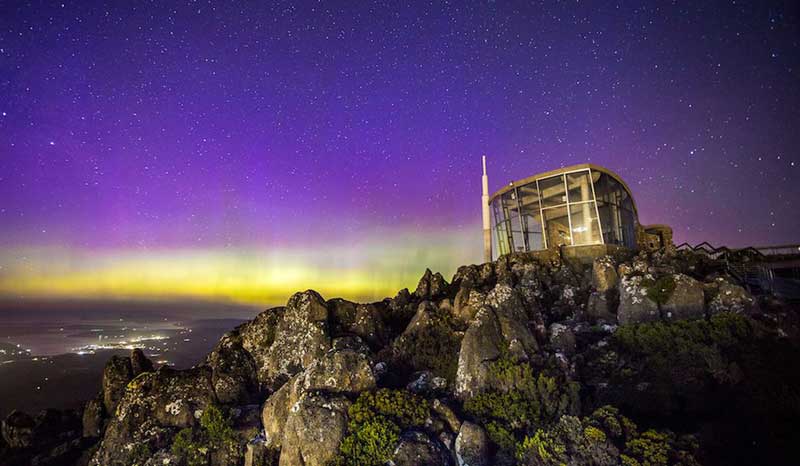Southern Aurora

Southern Aurora, Howden, Tasmania
In northern latitudes, the effect of an aurora is well known. It is given the name aurora borealis (or the northern lights), after the Roman goddess of dawn, Aurora, and the Greek name for the north wind, Boreas, by Pierre Gassendi in 1621. The northern lights have had a number of names throughout history. The Cree call this phenomenon the "Dance of the Spirits". In Europe, in the Middle Ages, the auroras were commonly believed a sign from God.
Lesser known is its southern counterpart, the aurora australis (or the southern lights), which has almost identical features to the aurora borealis and changes simultaneously with changes in the northern auroral zone. The aurora australis is visible from high southern latitudes in Antarctica, South America, New Zealand and Australia.
Tasmania, King Island and Southern Victoria are the most likely places to see aurora. However, on August 24, 2005 there was a massive auroral storm seen as far as Armidale in northern NSW. Naturally, the best views of any aurora will be away from the city and bright lights.
Observers in Tasmania are likely to see green glows or sheets of light in the southern sky. Observers in Southern Victoria are more likely to see a red glow in the southern sky, although more spectacular displays are possible.
Aurora will generally follow solar flares by about 2 days, and a number of instruments are watching the sun for these outbursts. The solar miniumin occured in 2006 and persisted for some time. While sunspot numbers, and hence flare rates are increasing, sometimes months will go by without an alert, then you have three in a week.

Southern Aurora seen from Mt Wellington. Photo: Smithsonian Magazine
What Is an Aurora?
An aurora (plural: aurorae or auroras) is a natural light display in the sky particularly in the high latitude (Arctic and Antarctic) regions, caused by the collision of energetic charged particles with atoms in the high altitude atmosphere (thermosphere).
The charged particles originate in the magnetosphere and solar wind and, on Earth, are directed by the Earth's magnetic field into the atmosphere. Aurora is classified as diffuse or discrete aurora. Most aurorae occur in a band known as the auroral zone which is typically 3° to 6° in latitudinal extent and at all local times or longitudes. The auroral zone is typically 10° to 20° from the magnetic pole defined by the axis of the Earth's magnetic dipole.
During a geomagnetic storm, the auroral zone will expand to lower latitudes. The diffuse aurora is a featureless glow in the sky which may not be visible to the naked eye even on a dark night and defines the extent of the auroral zone. The discrete aurora are sharply defined features within the diffuse aurora which vary in brightness from just barely visible to the naked eye to bright enough to read a newspaper at night.
Aurora occur when charged particles from the solar wind enter Earths outer atmosphere and interact with the oxygen and nitrogen atoms producing eerie displays of coloured lights. During solar maximum, which occurs every 11 years, the number and speed of the particles are higher, allowing them to penetrate the Earth's magnetic field at lower latitudes than normal.
Discrete aurorae are usually observed only in the night sky because they are not as bright as the sunlit sky. Aurorae occur occasionally poleward of the auroral zone as diffuse patches or arcs (polar cap arcs) which are generally invisible to the naked eye. Auroras seen near the magnetic pole may be high overhead, but from farther away, they illuminate the horizon as a greenish glow or sometimes a faint red, as if the Sun were rising from an unusual direction.
